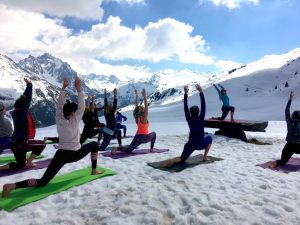Improve Physiological Adaptation to High Altitude with Yoga and Meditation
By John M. de Castro, Ph.D.
“Pranayama techniques allow for maximizing your lung capacity, which becomes critical at high altitudes.” – D.. M. Kumar
Breathing is essential for life and generally occurs automatically. It’s easy to take for granted as it’s been there our entire lives. Nevertheless, we become more aware of it when it varies with circumstances, such as when we exercise, in emotional states, especially fear and anxiety, and at high altitude. Breathing exercises are common in yoga practices and have been found to have a number of beneficial effects. High altitude taxes the physiology and particularly the respiratory system. Since yoga practice can improve respiratory function, it would be expected that yoga practice would improve the physiological adaptations needed to function at high altitude.
In today’s Research News article “Effect of mindfulness meditation protocol in subjects with various psychometric characteristics at high altitude.” (See summary below or view the full text of the study at: https://www.ncbi.nlm.nih.gov/pmc/articles/PMC7218243/) Bhanushali and colleagues recruited adults with no prior Kriya Yoga experience and provided them with an intensive 4-day 15 hours per day practice of Kriya Yoga at high altitude (11,500 ft.). The practice consisted of a combination of meditation and yoga. They were measured before and after training for body size, blood pressure, oxygen saturation, cholesterol, triglycerides, psychometric constitution (prakriti), attention, memory, verbal fluency, executive functioning, and information processing speed, anxiety, mental well-being, and happiness.
They found that in comparison to baseline, after the Kriya Yoga practice there were significant increases in oxygen saturation, blood glucose, mental well-being and happiness and significant decreases in anxiety, blood triglycerides and very low-density lipoprotein. Hence, after training there were improvements in physical and psychological well-being.
These results must be interpreted cautiously as there wasn’t a control comparison condition. So, the results could be due to acclimatization over the 4 days at high altitude and not to the Kriya Yoga practice. Also, without a control condition, participant expectancy effects (placebo), experimenter bias, attentional effects etc. may be responsible for the results. In addition, there was no comparison to other exercises. So, the effects may be due to exercise and not specifically to Kriya Yoga.
Taking this into consideration, the results demonstrate that intensive yoga practice can be conducted at high altitude and shows potential for improving physical and psychological acclimatization to high altitude.
So, improve physiological adaptation to high altitude with yoga and meditation.
“BREATHE — the universal mantra of yoga. This can be a bit harder than normal at thousands feet above sea level. There’s 20 percent less oxygen (or more!) in the air at these elevations. You may experience headache, fatigue, dizziness, nausea, shortness of breath, and sleep disturbance (and sleep is oh-so-important). If you’re feeling like you’re suffering from a bad hangover or the flu, chances are your body is struggling to adapt to the change in altitude.”.- Vicki Kahn
CMCS – Center for Mindfulness and Contemplative Studies
This and other Contemplative Studies posts are also available on Google+ https://plus.google.com/106784388191201299496/posts and on Twitter @MindfulResearch
Study Summary
Bhanushali, D., Tyagi, R., Limaye Rishi Nityapragya, N., & Anand, A. (2020). Effect of mindfulness meditation protocol in subjects with various psychometric characteristics at high altitude. Brain and behavior, 10(5), e01604. https://doi.org/10.1002/brb3.1604
Abstract
Introduction
Incidence of high altitude‐related sickness is increasing due to more number of people visiting the areas of high altitude which may result in life‐threatening conditions including acute mountain sickness (AMS), high altitude pulmonary edema (HAPE), high altitude cerebral edema (HACE), and High‐altitude pulmonary hypertension (HAPH). We hypothesized that an advanced yoga regimen may be beneficial in dealing with the physiology of acclimatization.
Methods
Anthropometric, Biochemical, and Psychological assessments were carried out in 48 participants before and after the advance meditation program (AMP) in the experimental group. Individuals with an age range of 20–65 years with no comorbidities were included in the study. Participants were exposed to AMP for 4 days. All assessments were carried out at the baseline and after the course. Prakriti was constituted for all participants using a standard questionnaire. The study was carried out after obtaining the written informed consent as per the guidelines outlined by the Institute Ethics Committee.
Results
Po2 and glucose levels were found significantly reduced along with changes in the Happiness index, anxiety, and mental well‐being. However, participants with lowered Po2, after 4 days of mindfulness intervention, showed a positive outcome measured by the established scales of anxiety, happiness, and information processing. Psychometric or Prakriti wise analysis revealed that subject with “Pitta” constitution exposed to high altitude and advance meditation showed changes in more parameters than “Vatta” or “Kapha” Constitution.
Conclusions
Advance meditation in the high altitude zone confers biochemical and neuro‐cognitive benefits. Molecular studies may require to understand the role of hypoxic condition in improving the disease state.
https://www.ncbi.nlm.nih.gov/pmc/articles/PMC7218243/
